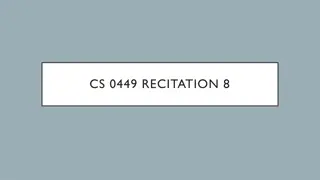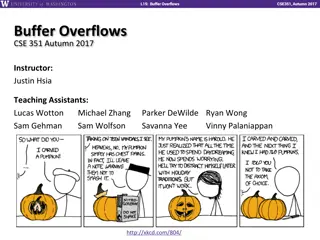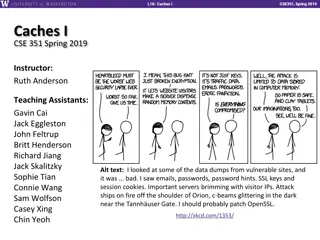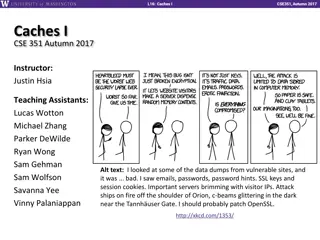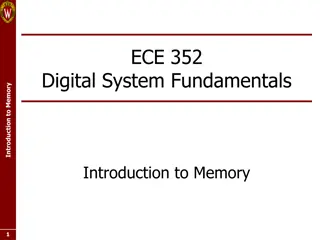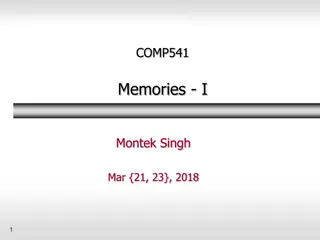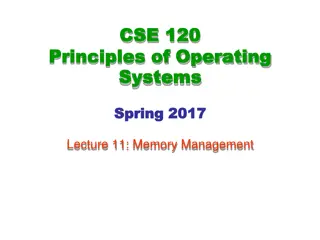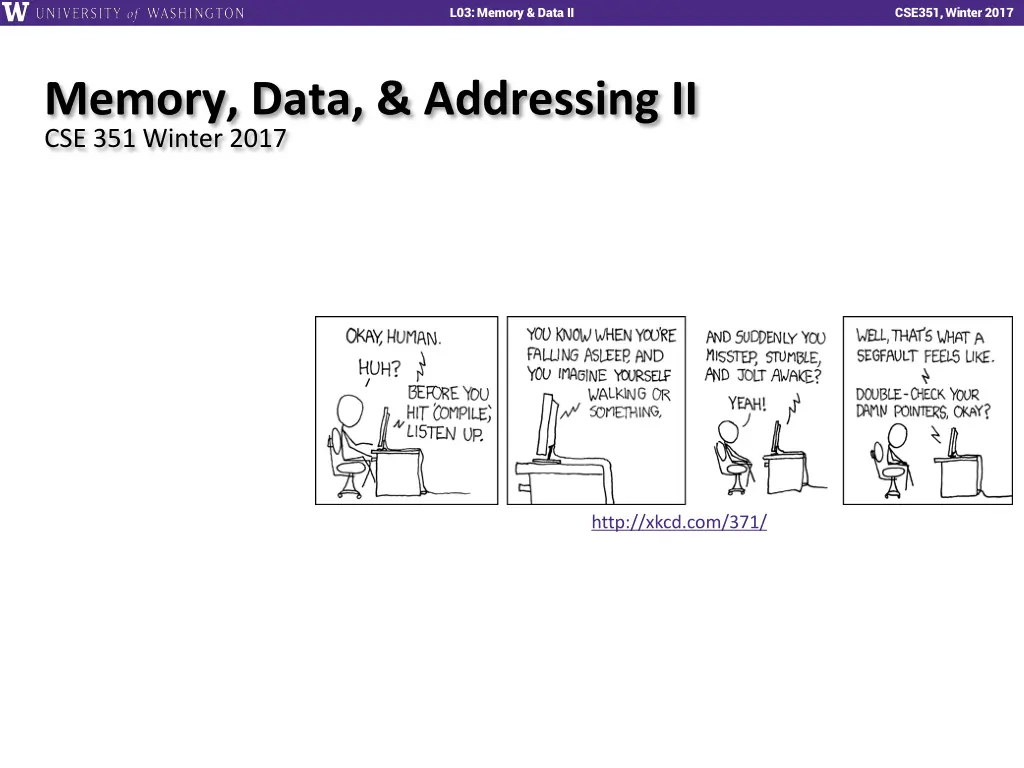
Combinational Logic and Memory Data in CSE Courses
Explore the concepts of intro, combinational logic, memory, and data in CSE courses. Learn about addresses, pointers, 64-bit examples, bit manipulation, variable declarations, and assignments in C. Dive into organizing, addressing, and manipulating data in memory using C and Boolean algebra.
Download Presentation

Please find below an Image/Link to download the presentation.
The content on the website is provided AS IS for your information and personal use only. It may not be sold, licensed, or shared on other websites without obtaining consent from the author. If you encounter any issues during the download, it is possible that the publisher has removed the file from their server.
You are allowed to download the files provided on this website for personal or commercial use, subject to the condition that they are used lawfully. All files are the property of their respective owners.
The content on the website is provided AS IS for your information and personal use only. It may not be sold, licensed, or shared on other websites without obtaining consent from the author.
E N D
Presentation Transcript
L01: Intro, Combinational Logic L03: Memory & Data II CSE369, Autumn 2016 CSE351, Winter 2017 Memory, Data, & Addressing II CSE 351 Winter 2017 http://xkcd.com/371/
L01: Intro, Combinational Logic L03: Memory & Data II CSE369, Autumn 2016 CSE351, Winter 2017 Administrivia Lab 0 due tomorrow @ 5pm Credit/no credit we ll talk about topics in depth later Lab 1 released later today @ 5pm Survey results: More detail how computers work, learn C, get a CE/CS major People from most continents! 2
L01: Intro, Combinational Logic L03: Memory & Data II CSE369, Autumn 2016 CSE351, Winter 2017 64-bit example (pointers are 64-bits wide) Review An address is a location in memory A pointer is a data object that holds an address Address can point to any data Address Pointer stored at 0x48 points to address 0x38 Pointer to a pointer! 0x00 0x08 0x10 0x18 0x20 0x28 0x30 0x38 0x40 0x48 01 00 00 00 00 00 5F 00 Is the data stored at 0x08 a pointer? 00 00 00 00 00 00 08 00 00 00 00 00 00 00 38 00 3
L01: Intro, Combinational Logic L03: Memory & Data II CSE369, Autumn 2016 CSE351, Winter 2017 Memory, Data, and Addressing Representing information as bits and bytes Organizing and addressing data in memory Manipulating data in memory using C Boolean algebra and bit-level manipulations 4
L01: Intro, Combinational Logic L03: Memory & Data II CSE369, Autumn 2016 CSE351, Winter 2017 Addresses and Pointers in C * is also used with variable declarations & = address of operator *= value at address or dereference operator Declares a variable, ptr, that is a pointer to (i.e. holds the address of) an int in memory int* ptr; Declares two variables, x and y, that hold ints, and sets them to 5 and 2, respectively int x = 5; int y = 2; Sets ptr to the address of x ( ptr points to x ) ptr = &x; y = 1 + *ptr; Sets yto 1 plus the value stored at the address held by ptr. Because ptr points to x, this is equivalent to y=1+x; Dereference ptr What is *(&y) ? 5
L01: Intro, Combinational Logic L03: Memory & Data II CSE369, Autumn 2016 CSE351, Winter 2017 Assignment in C A variable is represented by a memory location Declaration initialization (initially holds garbage ) int x, y; x is at address 0x04, y is at 0x18 0x00 A7 00 EE FA 26 00 01 FF DE 00 0x01 00 01 EE CE 00 00 00 00 AD 00 0x02 32 29 EE CA 00 10 00 F4 BE 00 0x03 00 F3 EE FE 00 00 00 96 EF 00 0x00 0x04 0x08 0x0C 0x10 0x14 0x18 0x1C 0x20 0x24 x y 6
L01: Intro, Combinational Logic L03: Memory & Data II CSE369, Autumn 2016 CSE351, Winter 2017 32-bit example (pointers are 32-bits wide) Assignment in C A variable is represented by a memory location Declaration initialization (initially holds garbage ) int x, y; x is at address 0x04, y is at 0x18 0x00 0x01 0x02 0x03 0x00 0x04 0x08 0x0C 0x10 0x14 0x18 0x1C 0x20 0x24 x 00 01 29 F3 y 01 00 00 00 7
L01: Intro, Combinational Logic L03: Memory & Data II CSE369, Autumn 2016 CSE351, Winter 2017 32-bit example (pointers are 32-bits wide) & = address of *= dereference Assignment in C left-hand side = right-hand side; LHS must evaluate to a memory location RHS must evaluate to a value (could be an address) Store RHS value at LHS location 0x00 0x01 0x02 0x03 0x00 0x04 0x08 0x0C 0x10 0x14 0x18 0x1C 0x20 0x24 int x, y; x 00 00 01 00 29 00 F3 00 x = 0; y 01 00 00 00 8
L01: Intro, Combinational Logic L03: Memory & Data II CSE369, Autumn 2016 CSE351, Winter 2017 32-bit example (pointers are 32-bits wide) & = address of *= dereference Assignment in C left-hand side = right-hand side; LHS must evaluate to a memory location RHS must evaluate to a value (could be an address) Store RHS value at LHS location 0x00 0x01 0x02 0x03 0x00 0x04 0x08 0x0C 0x10 0x14 0x18 0x1C 0x20 0x24 int x, y; x 00 00 00 00 x = 0; y = 0x3CD02700; little endian! y 01 00 00 27 00 D0 00 3C 9
L01: Intro, Combinational Logic L03: Memory & Data II CSE369, Autumn 2016 CSE351, Winter 2017 32-bit example (pointers are 32-bits wide) & = address of *= dereference Assignment in C left-hand side = right-hand side; LHS must evaluate to a memory location RHS must evaluate to a value (could be an address) Store RHS value at LHS location 0x00 0x01 0x02 0x03 0x00 0x04 0x08 0x0C 0x10 0x14 0x18 0x1C 0x20 0x24 int x, y; x 00 03 00 27 00 D0 00 3C x = 0; y = 0x3CD02700; x = y + 3; Get value at y, add 3, store in x y 00 27 D0 3C 10
L01: Intro, Combinational Logic L03: Memory & Data II CSE369, Autumn 2016 CSE351, Winter 2017 32-bit example (pointers are 32-bits wide) & = address of *= dereference Assignment in C left-hand side = right-hand side; LHS must evaluate to a memory location RHS must evaluate to a value (could be an address) Store RHS value at LHS location 0x00 0x01 0x02 0x03 0x00 0x04 0x08 0x0C 0x10 0x14 0x18 0x1C 0x20 0x24 int x, y; x 03 27 D0 3C x = 0; y = 0x3CD02700; x = y + 3; Get value at y, add 3, store in x int* z; z is at address 0x20 y 00 27 D0 3C z DE AD BE EF 11
L01: Intro, Combinational Logic L03: Memory & Data II CSE369, Autumn 2016 CSE351, Winter 2017 32-bit example (pointers are 32-bits wide) & = address of *= dereference Assignment in C left-hand side = right-hand side; LHS must evaluate to a memory location RHS must evaluate to a value (could be an address) Store RHS value at LHS location 0x00 0x01 0x02 0x03 0x00 0x04 0x08 0x0C 0x10 0x14 0x18 0x1C 0x20 0x24 int x, y; x 03 27 D0 3C x = 0; y = 0x3CD02700; x = y + 3; Get value at y, add 3, store in x int* z = &y + 3; Get address of y, add 3 , store in z y 00 27 D0 3C z 24 00 00 00 Pointer arithmetic 12
L01: Intro, Combinational Logic L03: Memory & Data II CSE369, Autumn 2016 CSE351, Winter 2017 Pointer Arithmetic Pointer arithmetic is scaled by the size of target type In this example, sizeof(int) = 4 int* z = &y + 3; Get address of y, add 3*sizeof(int), store in z &y = 0x18 24 + 3*(4) = 36 = 2*161 + 4*160 = 0x24 = 1*161 + 8*160 = 24 Pointer arithmetic can be dangerous! Can easily lead to bad memory accesses Be careful with data types and casting 13
L01: Intro, Combinational Logic L03: Memory & Data II CSE369, Autumn 2016 CSE351, Winter 2017 32-bit example (pointers are 32-bits wide) & = address of *= dereference Assignment in C int x, y; x = 0; y = 0x3CD02700; 0x00 0x01 0x02 0x03 0x00 0x04 0x08 0x0C 0x10 0x14 0x18 0x1C 0x20 0x24 x = y + 3; Get value at y, add 3, store in x int* z = &y + 3; Get address of y, add 12, store in z x 03 27 D0 3C y 00 27 D0 3C z *z = y; What does this do? 24 00 00 00 14
L01: Intro, Combinational Logic L03: Memory & Data II CSE369, Autumn 2016 CSE351, Winter 2017 32-bit example (pointers are 32-bits wide) & = address of *= dereference Assignment in C int x, y; x = 0; y = 0x3CD02700; 0x00 0x01 0x02 0x03 0x00 0x04 0x08 0x0C 0x10 0x14 0x18 0x1C 0x20 0x24 x = y + 3; Get value at y, add 3, store in x int* z = &y + 3; Get address of y, add 12, store in z x 03 27 D0 3C y 00 27 D0 3C The target of a pointer is also a memory location z *z = y; Get value of y, put in address stored in z 24 00 00 27 00 D0 00 3C 15
L01: Intro, Combinational Logic L03: Memory & Data II CSE369, Autumn 2016 CSE351, Winter 2017 Arrays are adjacent locations in memory storing the same type of data object Arrays in C ais a name for the array s address Declaration: int a[6]; 64-bit example (pointers are 64-bits wide) element type a[1] a[3] a[5] 0x2 0xA number of elements name 0x0 0x8 0x1 0x9 0x3 0xB 0x4 0xC 0x5 0xD 0x6 0xE 0x7 0xF 0x00 0x08 0x10 0x18 0x20 0x28 0x30 0x38 0x40 0x48 a[0] a[2] a[4] 16
L01: Intro, Combinational Logic L03: Memory & Data II CSE369, Autumn 2016 CSE351, Winter 2017 Arrays are adjacent locations in memory storing the same type of data object Arrays in C ais a name for the array s address The address of a[i] is the address of a[0] plus i times the element size in bytes Declaration: int a[6]; a[0] = 0x015f; a[5] = a[0]; Indexing: 0x0 0x8 0x1 0x9 0x2 0xA 0x3 0xB 0x4 0xC 0x5 0xD 0x6 0xE 0x7 0xF 0x00 0x08 0x10 0x18 0x20 0x28 0x30 0x38 0x40 0x48 a[0] a[2] a[4] 5F 01 00 00 5F 01 00 00 17
L01: Intro, Combinational Logic L03: Memory & Data II CSE369, Autumn 2016 CSE351, Winter 2017 Arrays are adjacent locations in memory storing the same type of data object Arrays in C ais a name for the array s address The address of a[i] is the address of a[0] plus i times the element size in bytes Declaration: int a[6]; a[0] = 0x015f; a[5] = a[0]; Indexing: No bounds a[6] = 0xBAD; checking: a[-1] = 0xBAD; 0x0 0x8 0x1 0x9 0x2 0xA 0x3 0xB 0x4 0xC 0x5 0xD 0x6 0xE 0x7 0xF 0x00 0x08 0x10 0x18 0x20 0x28 0x30 0x38 0x40 0x48 AD 0B 00 00 a[0] a[2] a[4] 5F 01 00 00 5F 01 00 00 AD 0B 00 00 18
L01: Intro, Combinational Logic L03: Memory & Data II CSE369, Autumn 2016 CSE351, Winter 2017 Arrays are adjacent locations in memory storing the same type of data object Arrays in C ais a name for the array s address The address of a[i] is the address of a[0] plus i times the element size in bytes Declaration: int a[6]; a[0] = 0x015f; a[5] = a[0]; Indexing: No bounds a[6] = 0xBAD; checking: a[-1] = 0xBAD; 0x0 0x8 0x1 0x9 0x2 0xA 0x3 0xB 0x4 0xC 0x5 0xD 0x6 0xE 0x7 0xF 0x00 0x08 0x10 0x18 0x20 0x28 0x30 0x38 0x40 0x48 int* p; p = a; p = &a[0]; *p = 0xA; Pointers: AD 0B 00 00 a[0] a[2] a[4] equivalent 5F 0A 01 00 00 00 00 00 5F 01 00 00 AD 0B 00 00 p 10 00 00 00 00 00 00 00 19
L01: Intro, Combinational Logic L03: Memory & Data II CSE369, Autumn 2016 CSE351, Winter 2017 Arrays are adjacent locations in memory storing the same type of data object Arrays in C ais a name for the array s address The address of a[i] is the address of a[0] plus i times the element size in bytes Declaration: int a[6]; a[0] = 0x015f; a[5] = a[0]; Indexing: No bounds a[6] = 0xBAD; checking: a[-1] = 0xBAD; 0x0 0x8 0x1 0x9 0x2 0xA 0x3 0xB 0x4 0xC 0x5 0xD 0x6 0xE 0x7 0xF 0x00 0x08 0x10 0x18 0x20 0x28 0x30 0x38 0x40 0x48 int* p; p = a; p = &a[0]; *p = 0xA; Pointers: AD 0B 0B 00 00 00 00 00 a[0] a[2] a[4] equivalent 5F 0A 01 00 00 00 00 00 5F 01 00 00 array indexing = address arithmetic (both scaled by the size of the type) p[1] = 0xB; *(p+1) = 0xB; p = p + 2; AD 0B 00 00 equivalent p 10 00 00 00 00 00 00 00 20
L01: Intro, Combinational Logic L03: Memory & Data II CSE369, Autumn 2016 CSE351, Winter 2017 Arrays are adjacent locations in memory storing the same type of data object Arrays in C ais a name for the array s address The address of a[i] is the address of a[0] plus i times the element size in bytes Declaration: int a[6]; a[0] = 0x015f; a[5] = a[0]; Indexing: No bounds a[6] = 0xBAD; checking: a[-1] = 0xBAD; 0x0 0x8 0x1 0x9 0x2 0xA 0x3 0xB 0x4 0xC 0x5 0xD 0x6 0xE 0x7 0xF 0x00 0x08 0x10 0x18 0x20 0x28 0x30 0x38 0x40 0x48 int* p; p = a; p = &a[0]; *p = 0xA; Pointers: AD 0B 0B 00 00 00 00 00 a[0] a[2] a[4] equivalent 0A 0C 00 00 00 00 00 00 5F 01 00 00 array indexing = address arithmetic (both scaled by the size of the type) p[1] = 0xB; *(p+1) = 0xB; p = p + 2; AD 0B 00 00 equivalent p 18 00 00 00 00 00 00 00 *p = a[1] + 1; 21
L01: Intro, Combinational Logic L03: Memory & Data II CSE369, Autumn 2016 CSE351, Winter 2017 Representing strings C-style string stored as an array of bytes (char *) Elements are one-byte ASCII codes for each character No String keyword, unlike Java 32 33 34 35 36 37 38 39 40 41 42 43 44 45 46 47 space ! # $ % & ( ) * + , - . / ASCII: American Standard Code for Information Interchange 48 49 50 51 52 53 54 55 56 57 58 59 60 61 62 63 0 1 2 3 4 5 6 7 8 9 : ; < = > ? 64 65 66 67 68 69 70 71 72 73 74 75 76 77 78 79 @ A B C D E F G H I J K L M N O 80 81 82 83 84 85 86 87 88 89 90 91 92 93 94 95 P Q R S T U V W X Y Z [ \ ] ^ _ 96 97 98 99 100 101 102 103 104 105 106 107 108 109 110 111 ` a b c d e f g h I j k l m n o 112 113 114 115 116 117 118 119 120 121 122 123 124 125 126 127 p q r s t u v w x y z { | } ~ del 22
L01: Intro, Combinational Logic L03: Memory & Data II CSE369, Autumn 2016 CSE351, Winter 2017 Null-Terminated Strings Example: Life is good stored as a 13-byte array Decimal:.. 76 105 102 101 32 105 115 32 103 111 111 100 Hex:.. 0x4c 0x69 0x66 0x65 0x20 0x69 0x73 0x20 0x67 0x6f 0x6f 0x64 0x00 Text:.. L i f e i 0 s g o o d \0 Last character followed by a 0 byte ( \0 ) (a.k.a. null terminator ) Must take into account when allocating space in memory Note that 0 \0 (i.e. character 0 has non-zero value) How do we compute the length of a string? Traverse array until null terminator encountered 23
L01: Intro, Combinational Logic L03: Memory & Data II CSE369, Autumn 2016 CSE351, Winter 2017 C (char = 1 byte) Endianness and Strings char s[6] = "12345"; SPARC (big endian) IA32, x86-64 (little endian) String literal 1 2 3 4 5 \0 31 32 31 32 0x00 0x01 0x02 0x03 0x04 0x05 0x00 0x01 0x02 0x03 0x04 0x05 33 34 35 00 33 34 35 00 0x31 = 49 decimal = ASCII 1 Byte ordering (endianness) is not an issue for 1-byte values The whole array does not constitute a single value Individual elements are values; chars are single bytes Unicode characters up to 4 bytes/character ASCII codes still work (just add leading zeros) Unicode can support the many characters in all languages in the world Java and C have libraries for Unicode (Java commonly uses 2 bytes/char) 24
L01: Intro, Combinational Logic L03: Memory & Data II CSE369, Autumn 2016 CSE351, Winter 2017 Examining Data Representations Code to print byte representation of data Any data type can be treated as a byte array by casting it to char C has unchecked casts !! DANGER !! void show_bytes(char* start, int len) { int i; for (i = 0; i < len; i++) printf("%p\t0x%.2x\n", start+i, *(start+i)); printf("\n"); } printf directives: %p Print pointer \t Tab %x Print value as hex \n New line 25
L01: Intro, Combinational Logic L03: Memory & Data II CSE369, Autumn 2016 CSE351, Winter 2017 Examining Data Representations Code to print byte representation of data Any data type can be treated as a byte array by casting it to char C has unchecked casts !! DANGER !! void show_bytes(char* start, int len) { int i; for (i = 0; i < len; i++) printf("%p\t0x%.2x\n", start+i, *(start+i)); printf("\n"); } void show_int(int x) { show_bytes( (char *) &x, sizeof(int)); } 26
L01: Intro, Combinational Logic L03: Memory & Data II CSE369, Autumn 2016 CSE351, Winter 2017 show_bytes Execution Example int a = 12345; // 0x00003039 printf("int a = 12345;\n"); show_int(a); // show_bytes((char *) &a, sizeof(int)); Result (Linux x86-64): Note: The addresses will change on each run (try it!), but fall in same general range int a = 12345; 0x7fffb7f71dbc 0x7fffb7f71dbd 0x7fffb7f71dbe 0x7fffb7f71dbf 0x39 0x30 0x00 0x00 27
L01: Intro, Combinational Logic L03: Memory & Data II CSE369, Autumn 2016 CSE351, Winter 2017 Summary Assignment in C results in value being put in memory location Pointer is a C representation of a data address & = address of operator *= value at address or dereference operator Pointer arithmetic scales by size of target type Convenient when accessing array-like structures in memory Be careful when using particularly when casting variables Arrays are adjacent locations in memory storing the same type of data object Strings are null-terminated arrays of characters (ASCII) 28






